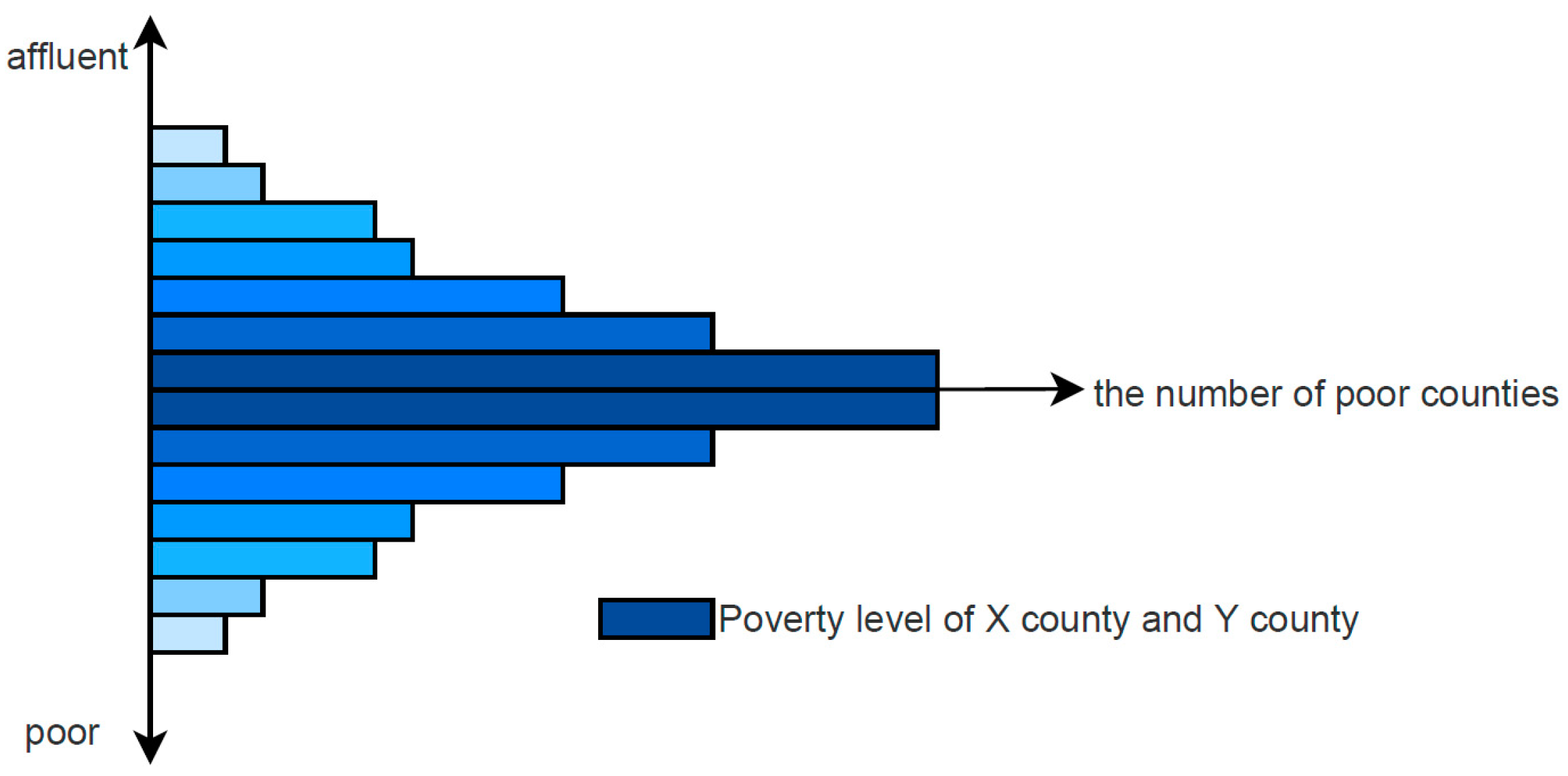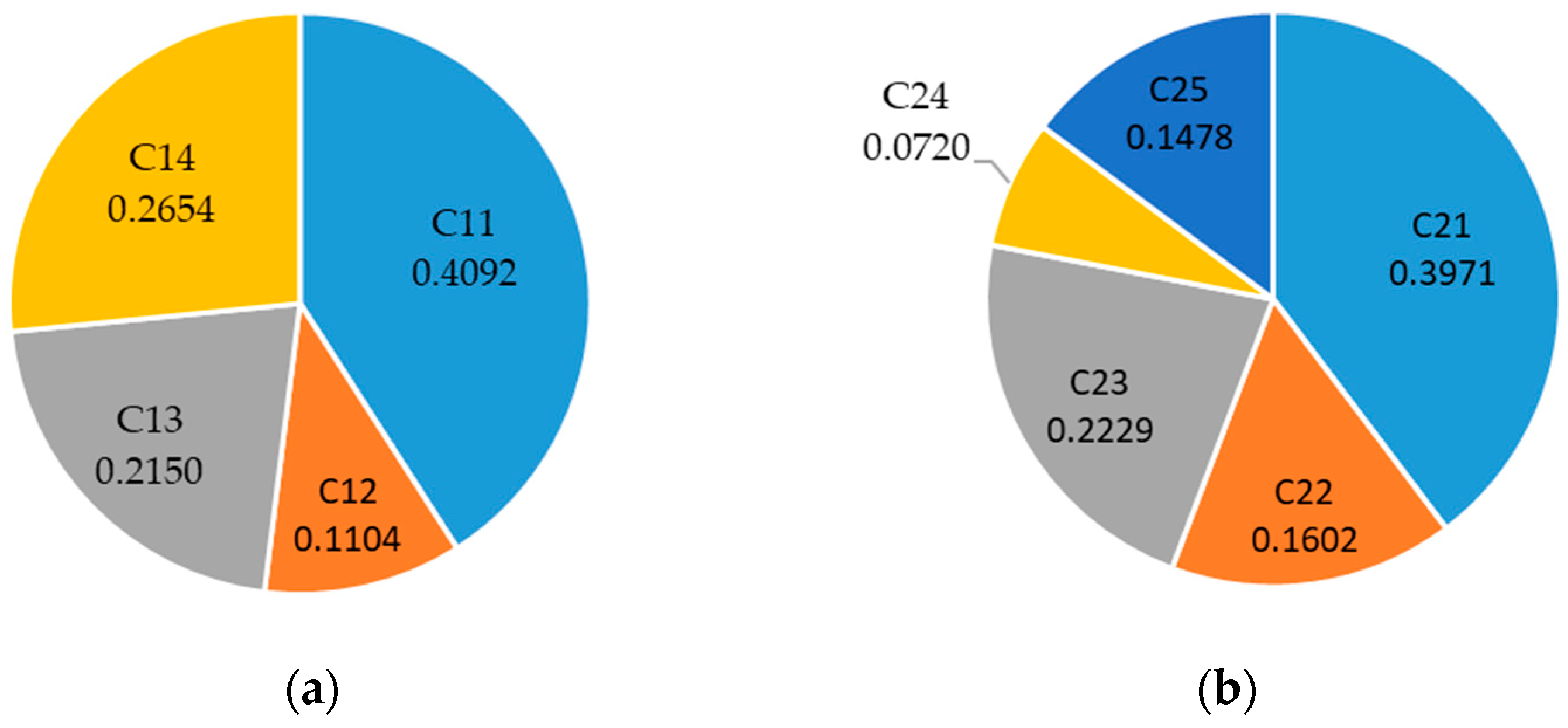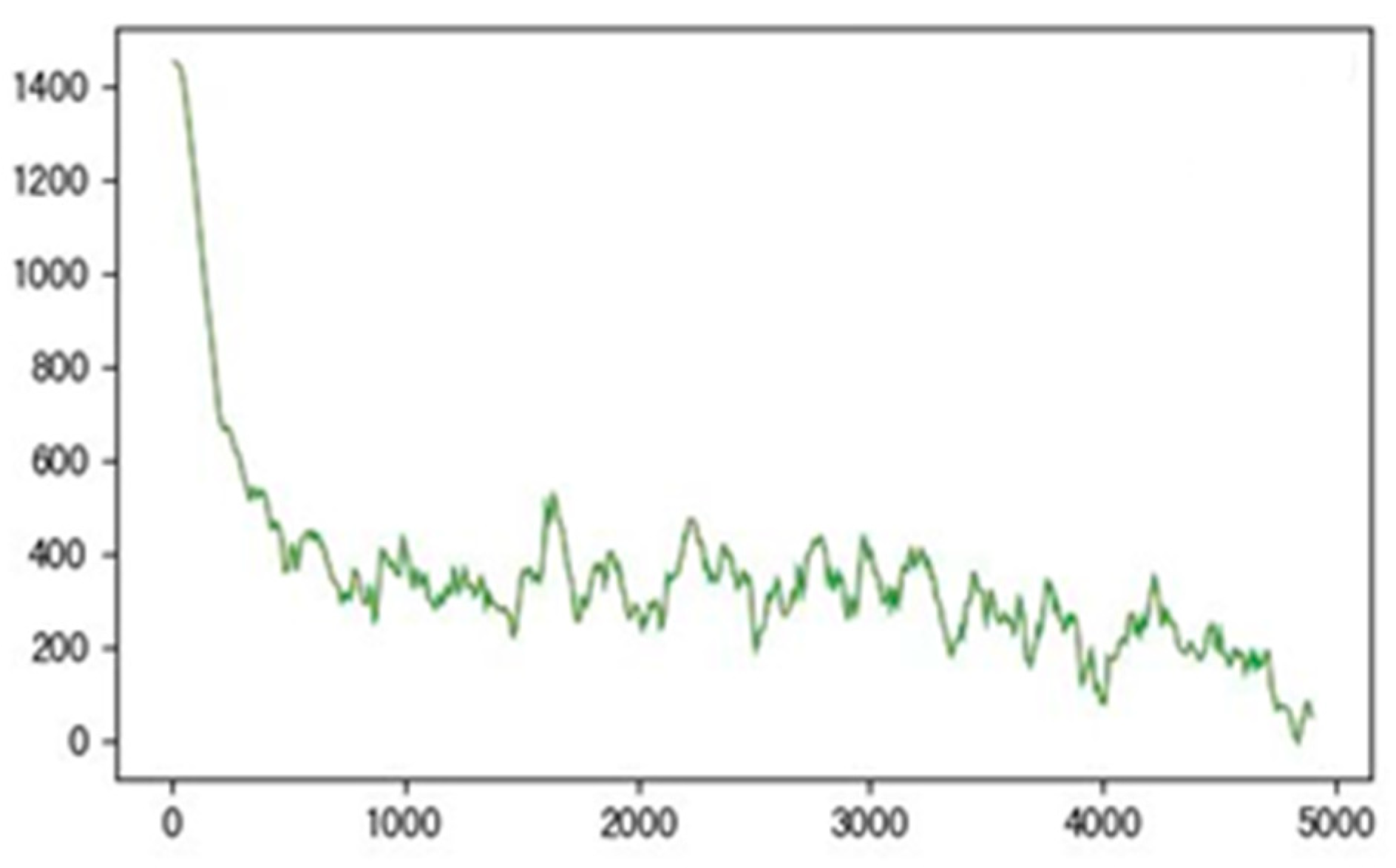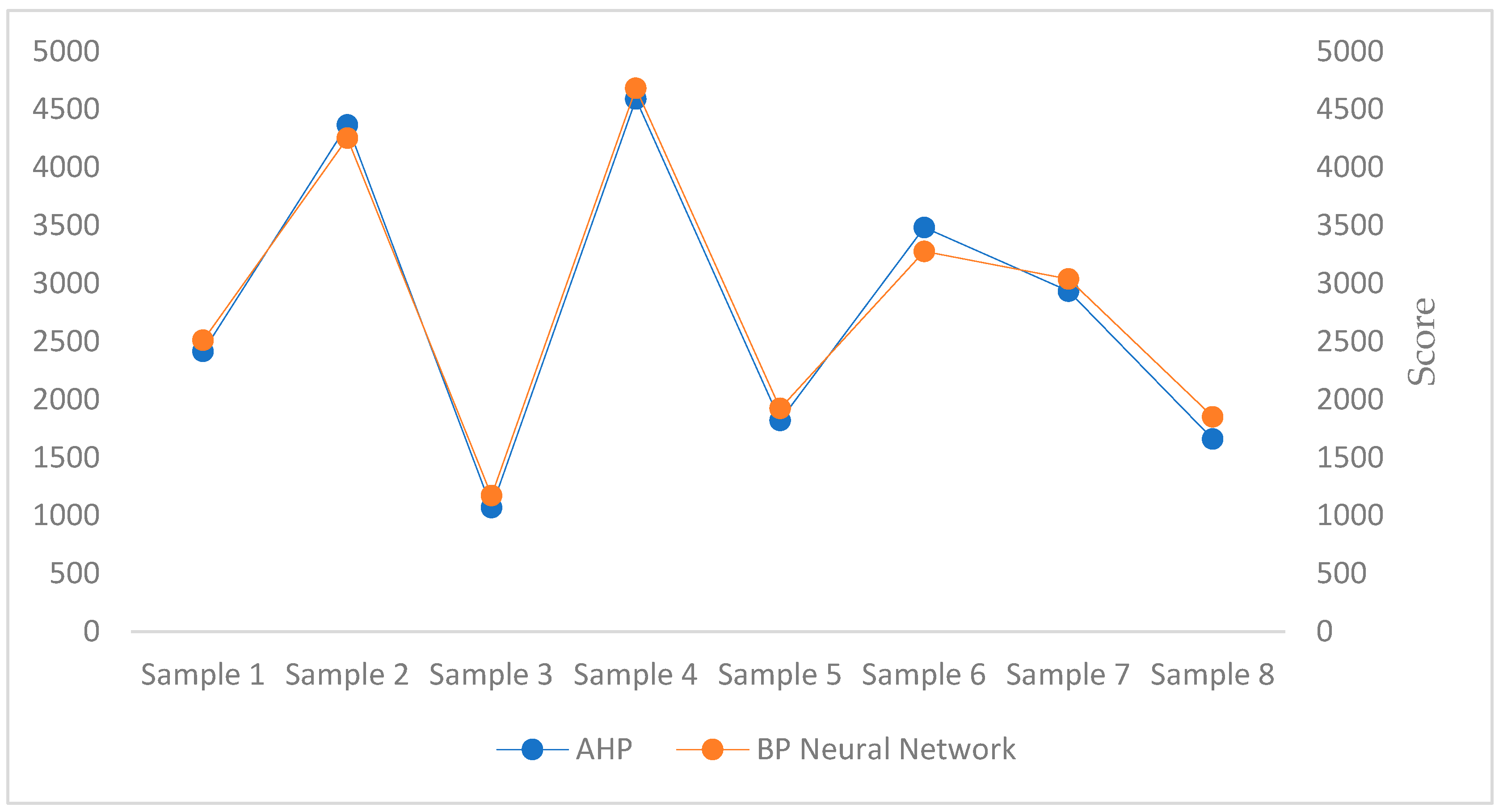Early Warning of Poverty Returning against the Background of Rural Revitalization: A Case Study of Two Counties in Guangxi Province, China
Abstract
1. Introduction
2. Materials and Methods
2.1. Study Area
2.2. Method
2.2.1. Analytic Hierarchy Process (AHP)
2.2.2. BP Neural Network Algorithm
2.3. Early Warning Evaluation Indicator System for Returning to Poverty
2.4. Data Collection
3. Results
3.1. Indicator Weight
3.2. Division of Early Warning Intervals for Returning to Poverty
3.3. Test Results of BP Neural Network
4. Discussion
5. Conclusions
- (1)
- According to the existing poverty reduction standards, four warning intervals have been identified. Farmers with a poverty-return warning evaluation score lower than or equal to 789.8923 are considered serious-warning farmers; farmers with scores above 789.8923 but below 859.0973 are classified as moderate-warning farmers; farmers with scores above 859.0973 and below 1575.0118 belong to households with mild warning; farmers with a score greater than 1575.0118 are non-warning farmers, with the lowest likelihood of returning to poverty and the most stable effects of poverty alleviation.
- (2)
- One household in X County has a severe early-warning status, accounting for 1.41% of the total number of households in the county; six households have a mild early-warning status, accounting for 8.45% of the total number of households in the county; sixty-four households do not have early-warning status, accounting for 90.14% of the total number of households in the county.
- (3)
- There are six households in Y County with severe early-warning status, 7.59% of the total number of households in the county, six households have mild early-warning status, 7.59% of the total number of households in the county, and sixty-seven households do not have early-warning status, accounting for 84.81% of the total number of households in the county.
- (4)
- The significant number of early-warning farmers is mainly caused by a lack of labor force and low annual per capita net income, as well as the lack of major livelihood means and capabilities. The presence of mild early-warning farmers is mainly caused by low annual per capita income and high proportion of non-labor income, as well as the lack of long-term development capabilities and methods.
- (1)
- For severe early-warning households: The government should provide social assistance such as minimum living security and special hardship support for this group, increase the proportion of medical expense reimbursement, improve the system of serious illness medical insurance, increase government transfer payments, and ensure that the existing rural labor force is not idle due to illness as much as possible. The government should also improve the borrowing and lending financial system, such as government guarantees for bank loans, providing start-up funds for farmers to participate in local planting and breeding industries, increasing per capita annual net income, and enhancing farmers’ livelihood ability.
- (2)
- For mild early-warning households: The government needs to encourage and guide this group to improve their self-development capabilities. Farmers need to be encouraged to develop industries with local regional characteristics such as rural tourism and planting and breeding, the implementation of corresponding supporting policies should be promoted, such as interest-free loans and tax exemptions, and opportunities should be provided for farmers to learn and train in science and technology. Technical support and problem-solving should be provided for farmers in deep rural areas in order to achieve the transformation of poverty alleviation models.
Author Contributions
Funding
Institutional Review Board Statement
Informed Consent Statement
Data Availability Statement
Acknowledgments
Conflicts of Interest
References
- Susana, L.; Celeste, E.; Partidário, M.D. Determinants for tourism and poverty alleviation. Tour. Manag. Stud. 2011, 7, 43–53. [Google Scholar]
- Pramod, K.; Harpalsinh, C. Evaluating poverty alleviation strategies in a developing country. PLoS ONE 2020, 15, e0227176. [Google Scholar] [CrossRef]
- Du, Y.; Zhao, R. Research progress on the effective connection between the achievements of consolidating and expanding poverty alleviation in ethnic areas and rural revitalization. Res. For. Grass Policies 2021, 1, 7. [Google Scholar] [CrossRef]
- Wang, Z.; Feng, Q. Strategies for consolidating poverty governance: From targeted poverty alleviation to rural revitalization. Res. Financ. Issues 2021, 10, 14–23. [Google Scholar] [CrossRef]
- Craig, D.; Porter, D. Poverty reduction strategy papers: A new convergence. World Dev. 2003, 31, 53–69. [Google Scholar] [CrossRef]
- Che, S.; Xie, J.; Shu, W. Multidimensional poverty measurement and analysis based on different weights. J. Quant. Econ. 2018, 9, 2. [Google Scholar] [CrossRef]
- Sen, A. Poverty: An Ordinal Approach to Measurement. Econometrica 1976, 3, 44. [Google Scholar] [CrossRef]
- Kimenyi, M.S. Rational Choice, Culture of Poverty, and the Intergenerational Transmission of Welfare Dependency. South. Econ. J. 1991, 57, 947–960. [Google Scholar] [CrossRef]
- Ahluwalia, M.; Carter, N.; Chenery, H. Growth and Poverty in developing Countries. J. Dev. Econ. 1979, 6, 299–341. [Google Scholar] [CrossRef]
- Luo, Y.; Li, H.; Hou, L.; Zhao, Z. Risk identification and early warning mechanism construction of rural tourism destination returning to poverty from the perspective of sustainable livelihood—Take W Village, Enshi Prefecture, Hubei Province as an example. Resour. Environ. Arid Areas 2022, 36, 186–193. [Google Scholar] [CrossRef]
- Huang, G.; Liu, Y.; Shi, P. Risk Assessment and Early Warning Mechanism Construction of Poverty Alleviation in Ethnic Areas. J. Huazhong Agric. Univ. (Soc. Sci. Ed.) 2021, 4, 79–88+181–182. [Google Scholar] [CrossRef]
- Sittha, P. Governance and Poverty Reduction in Thailand. Mod. Econ. 2012, 3, 487–497. [Google Scholar] [CrossRef]
- Hu, S.; Cao, Y. Risk Monitoring of Poverty Alleviation: Mechanism Setting, Dimensional Focus and Implementation Path. J. Northwest Univ. Agric. For. Sci. Technol. (Soc. Sci. Ed.) 2021, 21, 29–38. [Google Scholar] [CrossRef]
- Shen, Q. Research on the Early Warning Mechanism of Poverty Return in Northeast Border Minority Areas in the “Post Poverty Alleviation Era”. J. North Univ. Natl. 2020, 6, 41–48. [Google Scholar]
- Chen, S.; Ye, X.; Hou, D. Innovation of the governance mechanism for returning to poverty in the post targeted poverty alleviation era: An empirical survey based on H County, Jiangsu Province. J. Jiangsu Univ. Adm. 2021, 3, 113–120. [Google Scholar]
- Jiang, H.; Li, X.; Tian, Y. Research on the Long term Mechanism of Blocking Poverty Return. J. Soc. Sci. Jilin Univ. 2020, 60, 24–34+231–232. [Google Scholar] [CrossRef]
- Circular of the General Office of the State Council on Supervising and Encouraging the Implementation of “Relevant Major Policies and Measures with Remarkable Results” in 2019. Available online: http://www.gov.cn/zhengce/zhengceku/2020-05/08/content_5509889.htm (accessed on 11 May 2020).
- All the 54 Poverty-Stricken Counties in Guangxi “Take Off the Hat”, and the Guangxi Zhuang People Get Rid of Poverty as a Whole. Available online: https://www.chinanews.com.cn/gn/2020/11-20/9343242.shtml (accessed on 21 November 2020).
- 2019 Statistical Bulletin of National Economic and Social Development of X and Y Counties in Guangxi. Available online: https://www.monseng.com/1542783.html (accessed on 21 April 2020).
- Saaty, T.L. The Analytic Hierarchy Process; McGraw-Hill: New York, NY, USA, 1980. [Google Scholar]
- Saaty, T.L. Absolute and relative measurement with the AHP. Most Livable Cities United States. Socio-Econ. Plann. Sci. 1986, 20, 327–331. [Google Scholar] [CrossRef]
- Zhu, H.; Ren, X. On the Poverty in the Rocky Desertification Areas of Southwest China Based on AHP: A Case Study of Liupanshui City in. Asian Agric. Res. USA-China Sci. Cult. Media Corp. 2014, 6, 56–65. [Google Scholar] [CrossRef]
- Zhang, X.; Shi, L. Construction and demonstration of poverty early warning evaluation indicator system in the context of rural revitalization. Stat. Decis. Mak. 2021, 577, 58–62. [Google Scholar] [CrossRef]
- Rotermund, D.; Pawelzik, K.R. Back-Propagation Learning in Deep Spike-By-Spike Networks. Front. Comput. Neurosci. 2019, 13, 55. [Google Scholar] [CrossRef]
- Xu, B.; Zhang, H.; Wang, Z. Model and Algorithm of BP Neural Network Based on Expanded Multichain Quantum Optimization. Math. Probl. Eng. 2015, 5, 15–26. [Google Scholar] [CrossRef]
- Lee, J.H.; Delbruck, T.; Pfeiffer, M. Training Deep Spiking Neural Networks Using Backpropagation. Front. Neurosci. 2016, 10, 508. [Google Scholar] [CrossRef] [PubMed]
- Cheng, B.; Jia, G. Research on improved AHP-BP neural network algorithm—Taking circular economy evaluation of construction enterprises as an example. Manag. Rev. 2015, 27, 36–47. [Google Scholar] [CrossRef]
- Sun, C. Tunnel rockburst prediction model based on improved MATLAB BP neural network algorithm. J. Chongqing Jiaotong Univ. (Nat. Sci. Ed.) 2019, 38, 41–49. [Google Scholar]
- Lan, Q. Empirical Research on Comprehensive Stock Selection Based on Principal Component Analysis and BP Neural Network Algorithm; Jinan University: Guangzhou, China, 2017. [Google Scholar]
- Gu, J.; Wang, J.; Deng, J.; Wang, R. Water quality prediction based on ARIMA model and BP neural network algorithm. Water Purif. Technol. 2020, 39, 73–82. [Google Scholar] [CrossRef]
- Zhang, W.; Wu, Y.; Gong, Y. Risk prediction and cause analysis of returning to poverty of poor households with registered cards—Based on the field monitoring and research data of 25 provinces (districts and cities) in 2019. Reform 2020, 12, 110–120. [Google Scholar]
- Xie, N.; Zhang, L.; Fu, S. Sustainable livelihood and risk analysis of poverty free households in deep poverty areas—Based on the survey of 812 poor households in Liangshan Yi District. Soft Sci. 2020, 34, 6. [Google Scholar] [CrossRef]
- Zhang, W. Establishing an Early Warning Mechanism for Poverty Return Risk to Resolve the Risk of Poverty Return. People’s Forum 2019, 23, 68–69. [Google Scholar]
- Townsend, P. Poverty in the United Kingdom: A Survey of Household Resources and Standards of Living; University of California Press: Berkeley, CA, USA, 1979. [Google Scholar]
- UK Poverty 2019/2020 Report. Available online: https://www.Jrf.org.uk/report/uk-poverty-2019-20 (accessed on 7 February 2020).
- Henderson, R.F. Poverty in Australia. Canberra Aust. Gov. Publ. Serv. 1975, 1, 269–281. [Google Scholar]
- Hou, X.; Wu, H.; Wang, W. Identification and Measurement of Multidimensional Relative Poverty of Chinese Rural Adults Considering Climate Factors. Front. Environ. Sci. 2022, 10, 891077. [Google Scholar] [CrossRef]
- Thomas, H. The Effect of Education on Poverty: A European Perspective. Econ. Educ. Rev. 2021, 83, 102124. [Google Scholar] [CrossRef]
- Wu, M.; Jiao, L. A Study on the Quality of Life of Residents in Rural Tourism Destinations: A Case Study of Riga Village, Brazil. Front. Econ. Cult. 2022, 220, 52–55. [Google Scholar]
- Mao, Y.; Jin, Y.; Ouyang, H.; Li, C.; Hu, P. Research on the Safety Evaluation Index System of Mechanical Parking Equipment Based on Analytic Hierarchy Process and Expert Scoring Method. Lift. Transp. Mach. 2023, 623, 20–24. [Google Scholar]
- Saaty, T.L. Decision making— the Analytic Hierarchy and Network Processes (AHP/ANP). Syst. Sci. Syst. Eng. 2004, 13, 35. [Google Scholar] [CrossRef]
- Zhang, Y.; Wu, L. Stock market prediction of S&P 500 via combination of improved BCO approach and BP neural network. Expert Syst. Appl. 2009, 36, 8849–8854. [Google Scholar] [CrossRef]
- Some Standards and Assessment Requirements for Guangxi to Adjust Poverty Alleviation. Available online: http://www.gov.cn/xinwen/2018-05/07/content_5288754.htm (accessed on 7 May 2018).
- Chen, P. Linear Dimensionless Method Comparison and Reverse Index Forward Method. Oper. Res. Manag. 2021, 30, 95–101. [Google Scholar]
- Li, J.; Chen, W. Analysis of the Academic Impact of Heinrich’s Safety Theory. Chin. J. Saf. Sci. 2017, 27, 1–7. [Google Scholar] [CrossRef]
- Li, D. Research on Early Warning Evaluation of Poverty Return in the Context of Targeted Poverty Alleviation in Hebei Province; Hebei University: Baoding, China, 2020. [Google Scholar]
- Adato, M.; Meinzendick, R.S. Assessing the impact of agricultural research on poverty using the sustainable livelihoods framework. Biometrika 2010, 7, 452–504. [Google Scholar]
- Liu, Y.; Xu, Y. A geographic identification of multidimensional poverty in rural China under the framework of sustainable livelihoods analysis. Appl. Geogr. 2016, 73, 62–76. [Google Scholar] [CrossRef]
- Wang, Y.; Wang, M.; Huang, B.; Li, S.; Lin, Y. Evaluation and Analysis of Poverty-Stricken Counties under the Framework of the UN Sustainable Development Goals: A Case Study of Hunan Province, China. Remote Sens. 2021, 13, 4778. [Google Scholar] [CrossRef]
- Wang, G.; Xing, T. Analysis of the Mechanism of Precision Poverty Alleviation in China. Rural Econ. 2015, 395, 46–50. [Google Scholar]
- Yang, R.; Yang, Z. Poverty Alleviation by Helping the Disabled in Impoverished Mountainous Areas of Western China:Taking Luquan Yi and Miao Autonomous County in Yunnan Province as an Example. Asian Agric. Res. 2019, 11, 55–59. [Google Scholar] [CrossRef]
- Anh, V.T. Implementation of Poverty Reduction Policies in Ethnic Minority Regions in Vietnam: Evidence from CBMS; Socio-Economic Development Centre: Hanoi, Vietnam, 2004; pp. 314–318. [Google Scholar]
- Yang, J.; Li, Y. A Study on the Population Quality in the Development Process of Ethnic Poverty stricken Areas: A Case Study of Central Hainan. Guizhou Ethn. Stud. 2004, 3, 195–199. [Google Scholar]
- Zhao, Y. Research on Dynamic Monitoring of Poverty Prevention Based on Household Reports—Taking Qinba Mountain Area as an Example. Financ. Account. Commun. 2022, 19, 81–84+97. [Google Scholar] [CrossRef]
- Li, Z. Practice exploration and system construction of poverty prevention monitoring and assistance mechanism in poverty relief areas—Based on comparative analysis of two counties. J. Shanxi Agric. Univ. (Soc. Sci. Ed.) 2022, 21, 49–56. [Google Scholar] [CrossRef]
- Sun, Z.; Wang, T. Research on the construction of big data driven anti-poverty early warning mechanism from the perspective of dynamic poverty—Based on the practice and exploration of Sichuan L District. Electron. Gov. 2021, 12, 110–120. [Google Scholar] [CrossRef]
- Peng, J.; Chen, L.; Yu, B.; Zhang, X.; Huo, Z. Effects of multiple cropping of farmland on the welfare level of farmers: Based on the perspective of poverty vulnerability. Front. Ecol. Evol. 2022, 10, 988757. [Google Scholar] [CrossRef]
- Xie, C.; Li, T.; Liao, H.; Zhu, L.; Liu, T.; Zhou, T. Research on the influencing factors of stable poverty alleviation among farmers in Chongqing under the framework of sustainable livelihoods. J. Southwest Univ. (Nat. Sci. Ed.) 2023, 45, 2–13. [Google Scholar] [CrossRef]
- Ye, D.; Liu, Y. Evaluation and Application of Design Poverty Alleviation in Yao Ethnic Areas Based on Sustainable Framework Theory. Packag. Eng. 2022, 43, 157–165+175. [Google Scholar]




| Objective | Grade 1 | Grade 2 |
|---|---|---|
| Early Warning Evaluation of Returning to Poverty (A) | Survival Capability (B1) | Annual net income per capita (yuan) C11 |
| Basic medical coverage (%) C12 | ||
| Housing security (points) C13 | ||
| Forest land area (mu) C14 | ||
| Development Capability (B2) | Compulsory education guarantee (%) C21 | |
| Number of people burdened by the labor force per capita (person) C22 | ||
| Percentage of non-labor income (%) C23 | ||
| Sick and disabled population (%) C24 | ||
| Salary per capita of the labor force (yuan) C25 |
| Index | Mean | SE. | County |
|---|---|---|---|
| Annual net income per capita (yuan) | 11,868.57 | 740.11 | X |
| 9223.64 | 592.56 | Y | |
| Basic medical coverage (%) | 98.54% | 0.01 | X |
| 98.24% | 0.01 | Y | |
| Housing security (points) | 41.38 | 0.61 | X |
| 32.54 | 0.72 | Y | |
| Forest land area (mu) | 3.38 | 0.41 | X |
| 8.29 | 1.45 | Y | |
| Compulsory education guarantee (%) | 100.00% | 0.00 | X |
| 100.00% | 0.00 | Y | |
| Number of people burdened by the labor force per capita (person) | −4999.55 | 2452.08 | X |
| 2.05 | 0.12 | Y | |
| Percentage of non-labor income (%) | 78.40% | 0.03 | X |
| 86.28% | 0.02 | Y | |
| Sick and disabled population (%) | 79.18% | 0.03 | X |
| 72.98% | 0.04 | Y | |
| Salary per capita of the labor force (yuan) | 17,914.03 | 1402.66 | X |
| 14,019.60 | 974.92 | Y |
| Number | Weight Combination | Score Summary |
|---|---|---|
| 1 | (0.8, 0.2) | 12 |
| 2 | (0.7, 0.3) | 27 |
| 3 | (0.6, 0.4) | 45 |
| 4 | (0.5, 0.5) | 41 |
| 5 | (0.4, 0.6) | 32 |
| 6 | (0.3, 0.7) | 15 |
| 7 | (0.2, 0.8) | 11 |
| Objective | Grade 1 | Grade 2 | Comprehensive Weight |
|---|---|---|---|
| Early Warning Evaluation of Returning to Poverty (A) | Survival Capability (B1) | Annual net income per capita (yuan) C11 | 0.2455 |
| Basic medical coverage (%) C12 | 0.0662 | ||
| Housing security (points) C13 | 0.1290 | ||
| Forest land area (mu) C14 | 0.1592 | ||
| Development Capability (B2) | Compulsory education guarantee (%) C21 | 0.1589 | |
| Number of people burdened by the labor force per capita (person) C22 | 0.0641 | ||
| Percentage of non-labor income (%) C23 | 0.0892 | ||
| Sick and disabled population (%) C24 | 0.0288 | ||
| Salary per capita of the labor force (yuan) C25 | 0.0591 |
| Early Warning Range | (−∞, 789.8923] | (789.8923, 859.0973] | (859.0973, 1575.0118] | (1575.0118, +∞) |
|---|---|---|---|---|
| Early warning level | Severe Early Warning | Moderate Early Warning | Mild Early Warning | No Early Warning |
Disclaimer/Publisher’s Note: The statements, opinions and data contained in all publications are solely those of the individual author(s) and contributor(s) and not of MDPI and/or the editor(s). MDPI and/or the editor(s) disclaim responsibility for any injury to people or property resulting from any ideas, methods, instructions or products referred to in the content. |
© 2023 by the authors. Licensee MDPI, Basel, Switzerland. This article is an open access article distributed under the terms and conditions of the Creative Commons Attribution (CC BY) license (https://creativecommons.org/licenses/by/4.0/).
Share and Cite
Du, Y.; Zhao, R. Early Warning of Poverty Returning against the Background of Rural Revitalization: A Case Study of Two Counties in Guangxi Province, China. Agriculture 2023, 13, 1087. https://doi.org/10.3390/agriculture13051087
Du Y, Zhao R. Early Warning of Poverty Returning against the Background of Rural Revitalization: A Case Study of Two Counties in Guangxi Province, China. Agriculture. 2023; 13(5):1087. https://doi.org/10.3390/agriculture13051087
Chicago/Turabian StyleDu, Yaqi, and Rong Zhao. 2023. "Early Warning of Poverty Returning against the Background of Rural Revitalization: A Case Study of Two Counties in Guangxi Province, China" Agriculture 13, no. 5: 1087. https://doi.org/10.3390/agriculture13051087
APA StyleDu, Y., & Zhao, R. (2023). Early Warning of Poverty Returning against the Background of Rural Revitalization: A Case Study of Two Counties in Guangxi Province, China. Agriculture, 13(5), 1087. https://doi.org/10.3390/agriculture13051087





